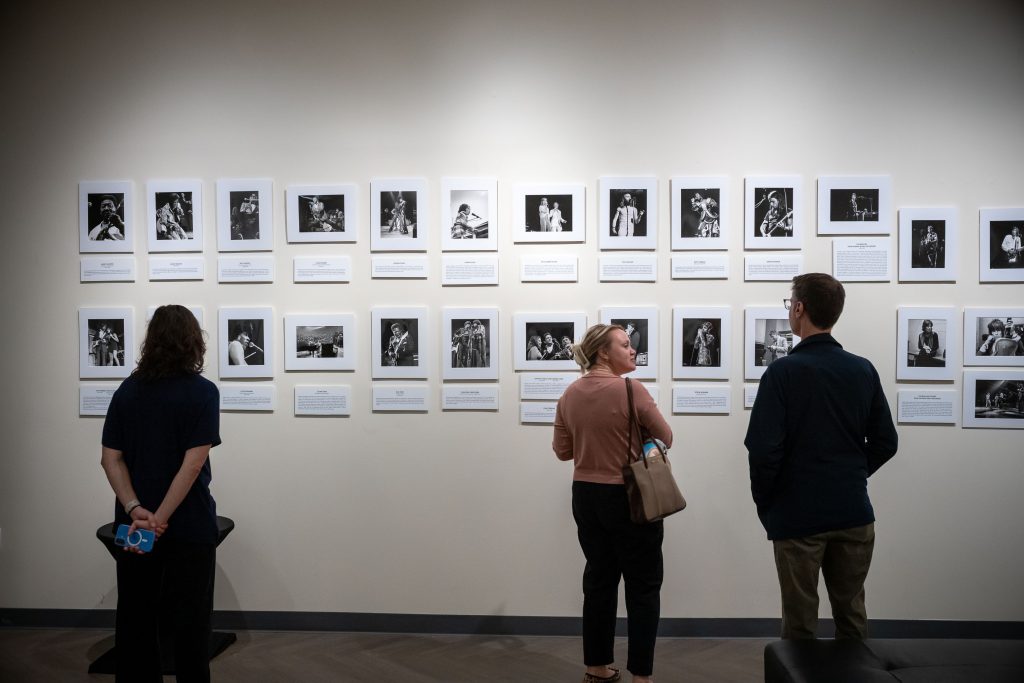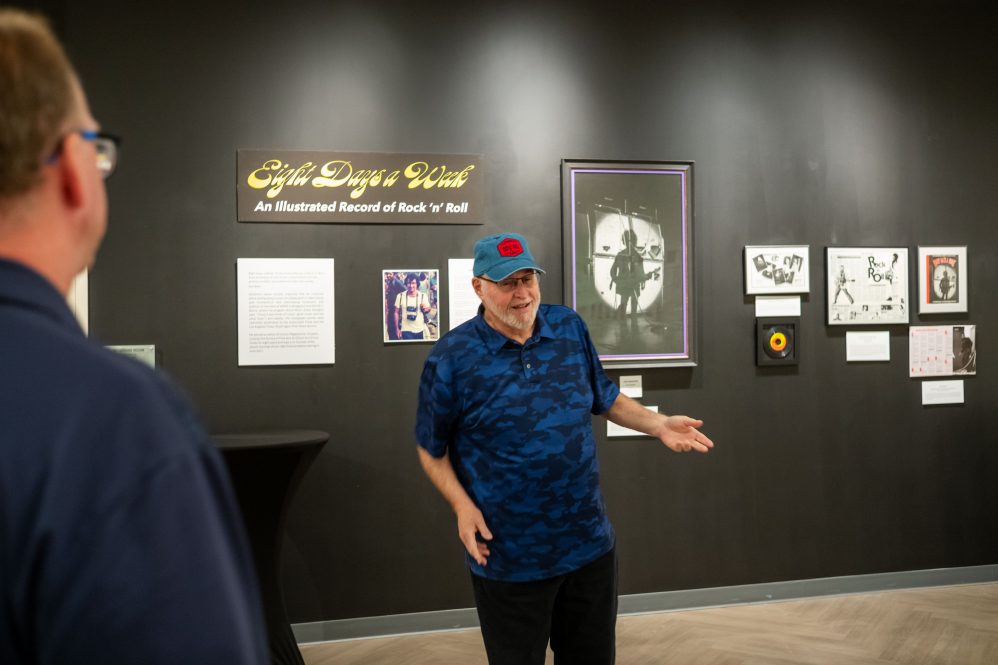A dream bill of Bob Dylan, the Beatles, the Rolling Stones, Led Zeppelin, and more are currently appearing at the Jorgensen Center for the Performing Arts – albeit in photographic form, in the Jorgensen Gallery.
“Eight Days a Week: An Illustrated Record of Rock ‘n’ Roll,” which opened in September and will run through December 13, is the product of years of research, archiving, and fandom by Ken Best – journalist, WHUS disk jockey, and recently retired University Communications specialist.
“I wanted to show the music industry as well as the music,” Best says. “Because, as an industry, you don’t just have musicians, you have artists doing graphic design, you have photographers, you have posters, you have authors and journalists producing books, and I’ve got a ton of that stuff that I’ve collected, starting with my time in high school.”
Best, a Woodstock attendee who interviewed numerous rock legends during his time as a journalist, assembled the impressively diverse collection in the Jorgensen Gallery from his own archives and from the work of Connecticut photographer Joe Sia, whose iconic photo of Jimi Hendrix in New Haven – known as “The Shadow” – adorned the cover of his and Best’s book “Eight Days a Week: An Illustrated Record of Rock and Roll,” which gives the exhibit its title.

“Joe’s photos from the book had never been seen all together before, other than in the book, so that was something I wanted to focus on,” says Best. Sia, who died in 2003, was a renowned photographer whose first published photo graced the cover of Rolling Stone Magazine in 1969.
Visitors to the exhibit can now see 53 striking photographs of performers from the period when rock ‘n’ roll went from being dismissed as a teen fad to being a serious popular art form.
But the exhibit also includes historic vinyl LPs; posters; promotional materials; books; magazines; and other ephemera that together tell the story of an American form of popular music that went on to conquer the world.
“The roots of rock ‘n’ roll are in jazz, the blues, gospel music, and country,” Best says. “I hope that people come away from the exhibit with an understanding of how those influences came together to make rock ‘n’ roll, and how rock ‘n’ roll then developed in lots of different directions.”
At first glimpse, there may not seem to be much in common between rock ‘n’ roll pioneer Chuck Berry and heavy metal thunderers like Led Zeppelin, but Best says a straight line can be drawn between them, and further on into the present.
“You start with country blues, and that becomes electric blues and r&b, and that becomes an open door for English guitarists like Keith Richards, Eric Clapton, or Jimmy Page to take things to new levels of baroque extravagance, as Sam Charters said in his book ‘Walking a Blues Road,’ the anthology of his pioneering writings about the blues that are part of his blues archives here at the Dodd Center,” Best says.
Best says the experience of putting the exhibit together was gratifying, and that he’d like to take it on the road – ideally to somewhere in Fairfield County, where Sia lived.
For now, though, the exhibit has a few more weeks at the Jorgensen Gallery and Best, who spins records every Wednesday at 3 p.m. on WHUS, still has his ears open for good music.
“I hope people come away from this with an appreciation not just of where music is now, but how it got there,” he says.
An excellent time to stop by the “Eight Days a Week” exhibit will be Saturday, Nov. 8, before the performance by Zoso, a Led Zeppelin tribute. Here, Best himself describes the band’s appeal, and interviews co-founder Adam Sandling:
ZOSO: THE ULTIMATE LED ZEPPELIN EXPERIENCE comes to Jorgensen Center for the Performing Arts on the UConn Storrs campus as part of its 30th anniversary tour on Saturday, Nov. 8 at 8 p.m.
Zoso has become one of the most iconic and respected Led Zeppelin tribute experiences in the world, having played over 4,800 shows across the globe. Known for their unparalleled dedication to faithfully recreating the legendary band’s live performances, Zoso has earned accolades from both critics and fans alike.
Led Zeppelin, which had 10 Top 10 albums, including six that reached No. 1 on the charts, is considered one of the most influential rock ‘n’ roll bands of all time. The group, formed in 1968 by guitarist Jimmy Page (with John Paul Jones on bass, John Bonham on drums and vocalist Robert Plant) led the development of album-oriented rock and stadium rock. With albums such as “Houses of the Holy” and “Physical Graffiti,” Led Zeppelin is one of the best-selling bands in history. Its best-known song, “Stairway to Heaven” from “Led Zeppelin IV,” was never released as a single. The band was Inducted into the Rock and Roll Hall of Fame in 1995.
Zoso’s live performances focus on the raw energy and intricate musicality of Led Zeppelin’s best-known hits and deeper tracks, with a particular emphasis on recreating their live show experience. The band’s commitment to authenticity has earned them praise from major outlets, with the L.A. Times calling them “head and shoulders above all other Led Zeppelin tributes,” and the St. Petersburg Times describing them as “the most exacting of all the Led Zeppelin tributes.”
The word “Zoso” was one of four symbols selected by band members for the cover of Led Zepplin IV, which has been explained as a symbol selected by Page and understood to represent the mythological Roman god Saturn, the ruler of Capricorn in astrology.
The band was founded in 1995 by Matt Jernigan and Adam Sandling, both of whom are renowned for their exceptional musicianship and passion for Led Zeppelin’s music. Vocalist Jernigan takes on the role of Plant and Sandling plays bass, keyboards, and mandolin. In 2015, Bevan Davies joined Zoso on drums and earlier this year Holton Rainero joined on guitar.
Sandling spoke about the formation of Zoso and the legacy of Led Zeppelin with WHUS on the Good Music show (Wednesdays from 3:00 p.m. to 5:30 p.m.).



